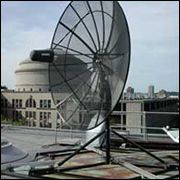Description

A 2.5 meter computer-controlled alt-azimuth parabolic dish antenna. (Image courtesy of MIT Junior Lab staff.)
This experiment measures the Doppler spectrum of interstellar atomic hydrogen and the dynamics of the galactic rotation. A 2.5-meter computer-controlled alt-azimuth parabolic dish antenna, located on a roof at MIT, is used with a heterodyne measurement chain and digital correlator to observe the Doppler spectrum of the 21-cm hyperfine line of interstellar atomic hydrogen in various directions along the Milky Way. Features of the spiral-arm structure of the Galaxy are deduced from the measured radial velocities of the HI clouds in the galactic disc.
Lab Guide
21-cm Radio Astrophysics Lab Guide (PDF)
References
Ewen, H. I., and E. M. Purcell. “Observation of a Line in the Galactic Radio Spectrum.” Nature 168 (1951): 356.
Lerner, Rita G., and George L. Trigg. “Radio Astronomy.” In Encyclopedia of Physics. Reading, MA: Addison-Wesley, 1981, pp. 41-42. ISBN: 9780201043136.
Kraus, John D. “Radio Astronomy of the Sun.” in Radio Astronomy: 2nd Edition. Durham: Cygnus-Quasar Books, 1986. ISBN: 9781882484003.
———. “Hydrogen Line Emission and Galactic Structure.” in Radio Astronomy: 2nd Edition. Durham: Cygnus-Quasar Books, 1986. ISBN: 9781882484003.
Schlovsky, I., R. B. Rodman, and C. M. Varsavsky. “Monochromatic Galactic Radio Waves.” Chapter 4 in Cosmic Radio Waves. Cambridge, MA: Harvard University Press, 1960. ISBN: 9780674174511.
Mihalas, Dimitri, and James Binney. “Galactic Rotation and the Spiral Structure of Our Galaxy.” Chapter 8 in Galactic Astronomy. San Francisco, CA: W.H. Freeman, 1968.
Shu, Frank H. “Our Galaxy: The Milky Way System.” Chapter 12 in The Physical Universe: An Introduction to Astronomy. Mill Valley, CA: University Science Books, 1982. ISBN: 9780935702057.
This reference gives a clear description of the interpretation of 21cm spectra in terms of the rotation curve of the Galaxy.
Particle Data Group: Astrophysical Constants and Parameters (PDF)
Tuve, M. A., and S. Lundsager. “Velocity Structures in Hydrogen Profiles: A Sky Atlas of Neutral Hydrogen Emission.” Carnegie Institution of Washington Publication, no. 630 (1973). ISBN: 9780872796416.
Van de Hulst, H.C. “The Spiral Structure of the Outer Part of the Galactic System Derived from the Hydrogen Emission at 21cm Wave Length.” Bulletin of the Astronomical Institutes of the Netherlands, Vol. 12, Number 452, (1954): 117-149.
Kerr, F. J. “The Large Scale Distribution of Hydrogen in the Galaxy.” Annu. Rev. Astro. Astrophys, Vol. 7, Number 1 (1969): 39-66.
Haystack Radio Telescope User’s Manual (PDF)
Selected Resources
NOAA Solar Position Calculator
Wikipedia Entry on the Milky Way Galaxy
Cambridge University Press Handbook of Space Astronomy and Astrophysics
Kraus, John D. “Radio-Telescopy Antennas.” in Radio Astronomy: 2nd Edition. Durham: Cygnus-Quasar Books, 1986. ISBN: 9781882484003.
Kraus, John D. “Radio-Telescopy Recievers.” in Radio Astronomy: 2nd Edition. Durham: Cygnus-Quasar Books, 1986. ISBN: 9781882484003.
UC San Diego Center for Astrophysics & Space Sciences - Prof. Gene Smith’s Astronomy Tutorial
Small Radio Telescope Engineering Resources
Haystack Observatory’s Small Radio Telescope Website is a very important site for students to investigate. Detailed block diagrams and schematics of the 21-cm receiver, mount and ground controller are available there.
Electronic Noise Calibrator for the Small Radio Telescope (PDF)
MIT course 6.661 Receivers, Antennas, and Signals on MIT OpenCourseWare








